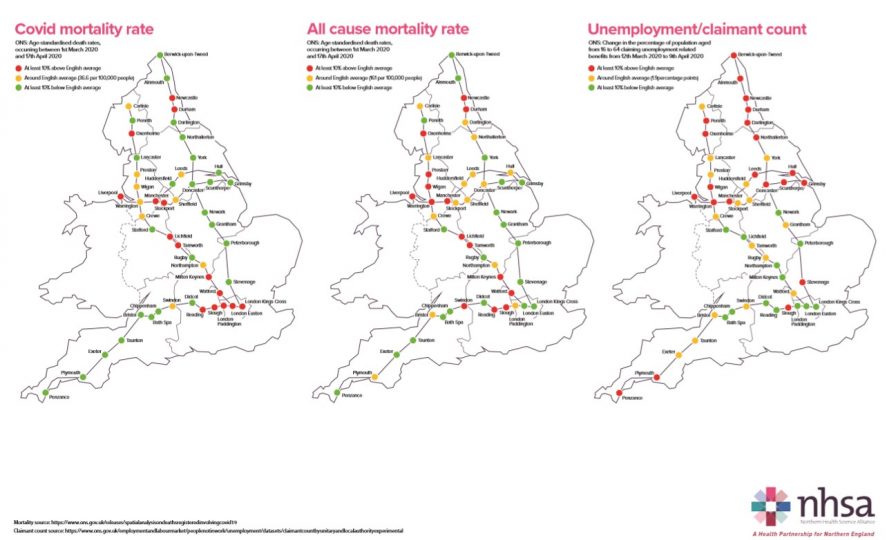Productivity in the UK, and particularly in the northern regions of England, has remained stubbornly low for decades, prompting economists to discuss a ‘productivity puzzle’. Here, Dr Luke Munford, explains how his research into health inequalities in northern England shows that investing in the health of the population could translate directly into substantial gains in productivity and output across the regions of the Northern Powerhouse.
- The ‘Northern Powerhouse’ still lags behind the south and south east of England in both health and economic outcomes.
- Research conducted by the Northern Health Science Alliance has shown that the differences in heath can be a major driver of differences in productivity.
- Investing in overcoming regional health inequalities can therefore result in substantial increases in productivity and GDP for the whole country.
The ‘Northern Powerhouse’ is “the government’s vision for a super-connected, globally-competitive northern economy with a flourishing private sector, a highly-skilled population, and world-renowned civic and business leadership” and consists of the majority of northern England, including Manchester, Liverpool, Leeds, Sheffield, Hull, Newcastle, and many smaller towns and other cities.
However, the Northern Powerhouse does – on average – worse than the rest of the country with respect to both health and economic outcomes.
One of the major driving factors for the creation of the Northern Powerhouse was to build a joined-up north that could ultimately equal south/south-east England in terms of economic performance and productivity.
Regional differences in health
There are deep-rooted and persistent regional health inequalities within England. People who live in the north tend to have much lower levels of health than their counterparts elsewhere (.pdf) and there is a two-year gap in life-expectancy. One frightening result of this is that over the last 50 years, over 1.5 million northerners have died earlier than if they had experienced the same lifetime health chances as those in the rest of England.
Premature mortality rates in Manchester are 539 deaths per-100,000 population, compared to 241 deaths per 100,000 in Kensington and Chelsea.
It is not just length of life; there are also marked differences in the quality of health between the north and elsewhere. The ‘Due North Inquiry’ into health equity reported that a baby boy born in Manchester can expect to live 17 fewer years in good health than a baby boy born in Richmond Upon Thames. A baby girl born in Manchester can expect to live 15 fewer years in good health than a baby girl born in Richmond.
Regional difference in wealth
As well as stark differences in health, there are also large differences in wealth and other measures of economic conditions. For example, there is a £4 per-person-per-hour difference in productivity (measured using average Gross Value Added; GVA); the average GVA per-worker in the Northern Powerhouse is £28, compared to £32 nationally. If productivity in the Northern Powerhouse increased to match the UK average, it would equate to a potential £44 billion real terms gain to UK GDP (.pdf).
The Northern Powerhouse also has lower levels of economic activity rates (implying higher rates of unemployment and economic inactivity) , and even when in employment the average annual earnings in the Northern Powerhouse are 10% lower than the rest of England.
The relationship between the two
Given that both health and wealth are lower in the Northern Powerhouse, a natural question to ask is “Are these things connected?” with a follow-up question being “If we reduce the differences in health, will we benefit from higher productivity?”
In our recent report, funded through the Northern Health Science Alliance (NHSA), we answer exactly these questions.
First, at a local authority level, we show that there is a strong association between morbidity (ill health) and measures of economic performance (including GVA, employment rate, and the weekly wage). Decreasing the number of people with ill-health by 10% in the Northern Powerhouse will:
- increase rates of economic activity by 4 percentage points; the corresponding figure for the rest of England is 2 percentage points
- increase productivity by 4%; the corresponding figure for the rest of England is 0%
The economic gains associated with improved public health are much larger in the Northern Powerhouse than the rest of England.
Second, we show that increasing NHS budgets in the Northern Powerhouse by 10% will:
- increase the rates of economic activity by 3 percentage points (compared to 2 percentage points in the rest of England)
- increase productivity by 0.7% (compared to 0.4% in the rest of England)
Again, the returns are much larger for increases in NHS budgets in the Northern Powerhouse compared to the rest of England. These results, however, must bear in mind that average NHS spending is already higher, on average, in the Northern Powerhouse than elsewhere.
Finally, by analysing what causes the difference in productivity between the Northern Powerhouse and the rest of England, we show that around 30% of the productivity gap (of £4 per-person-per-hour, or £44bn per-year) can be attributable to worse health in the Northern Powerhouse. If we were to eradicate this gap, and make people in the Northern Powerhouse as healthy as their compatriots, a further £13.2bn could be added to UK GDP.
Recommendations
In the report, we make a number of recommendations. A selection of these are presented below.
Central Government:
- To improve health in the north by increasing investment in place-based public health in Northern Powerhouse local authorities.
- To improve labour market participation and job retention amongst people with a health condition in the Northern Powerhouse. For example, people with long-term conditions could be given extra assistance to enable them to maintain their job. This could include different working arrangements, easier availability of necessary equipment, and greater flexibility.
- To increase NHS funding in the Northern Powerhouse – to be spent on prevention services and health science research. The increases in spending could be brought about by, for example, giving a higher weighting to deprivation measures.
- To reduce economic inequality between the north and the rest of England by implementing an inclusive, green industrial strategy
Northern Powerhouse local and regional stakeholders:
- Health and Wellbeing Boards and the emerging NHS integrated care systems should commission more health promotion, condition management and prevention services.
- Local Enterprise Partnerships, local authorities and devolved northern regions should develop locally tailored ‘health-first’ programmes in partnership with the local NHS and third sector providers.
- Local Enterprise Partnerships, local authorities and devolved Northern regions should scale-up their place-based public health programmes across the life course: ‘starting well’, ‘living well’ and ‘ageing well’.
- Local businesses should support job retention and health promotion interventions across the Northern Powerhouse workforce and northern city regions and northern NHS integrated care systems should lead by example.
Post-script: Covid-19
This analysis was conducted pre-Covid-19. Follow up research has shown that Covid-19 maybe disproportionally hitting the Northern Powerhouse, particularly with respect to economic outcomes (unemployment rate). This reinforces the message that investments in public health in the Northern Powerhouse are now more important than ever.
Policy@Manchester aims to impact lives globally, nationally and locally through influencing and challenging policymakers with robust research-informed evidence and ideas. Visit our website to find out more, and sign up to our newsletter to keep up to date with our latest news.

